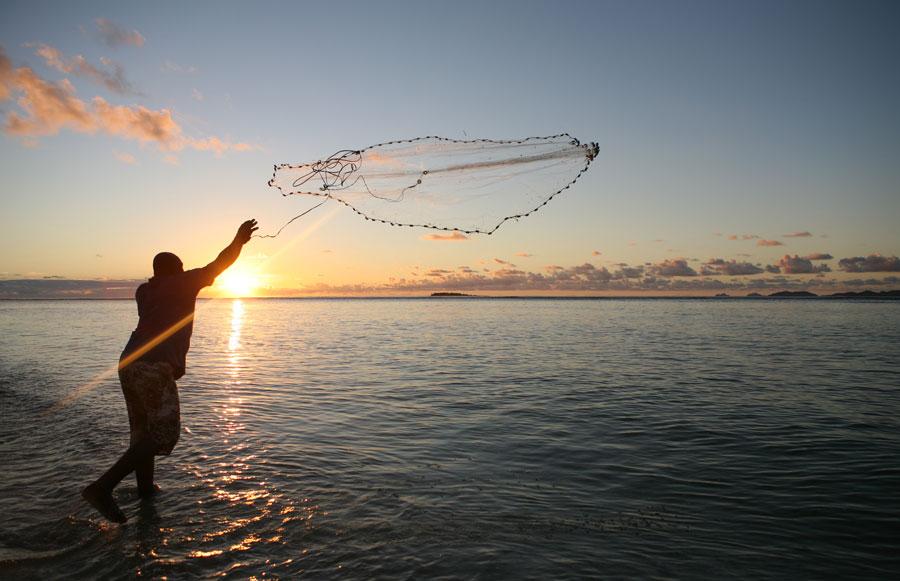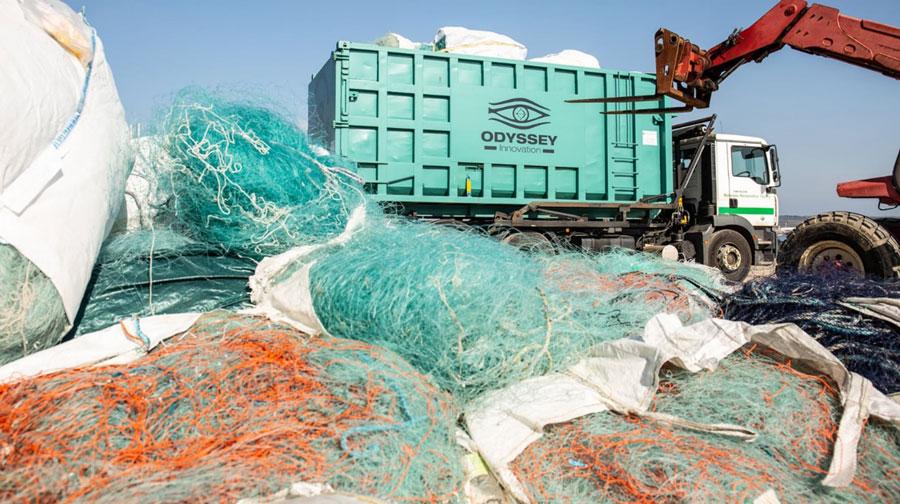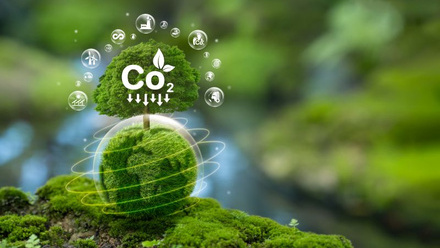Net gains – the marine litter challenge
Researchers at the University of Plymouth on confronting the issue of marine debris.

This article was produced by Dr Jasper Graham-Jones MIMMM, Associate Professor in Mechanical & Marine Engineering, Professor John Summerscales FIMMM, Professor of Composites Engineering, and Research Associates Ben Bryant and Amanda Burton.
Vehicle tyres wear on roads producing particles that then drain into rivers and the sea. Meanwhile, old tyres are cut into strips and used for seafood (crab/lobster/whelks) pots, or cut into disks to allow trawl nets to run along the bottom of the seabed. It becomes difficult to tell if rubber tyre particles on the shore or seabed have come straight from tyres or subsequent uses. Either way, they must be prevented from forming micro-tyre particles, or be collected as close to source as possible.
In 2004, the critical nature of such micro-plastics was identified at the University of Plymouth, UK, by Professor Richard Thompson, who is now running its Preventing Plastic Pollution project.
Micro-plastics have been found in all seas and most sea creatures, accumulating in apex-predators, which are at the top of the food chain.
Leakage is damaging because this designed-in durability means that they persist in the environment. Toxic effects are being investigated in Plymouth’s INnovative fIshing Gear for Ocean (INdIGO) and SeaBioComp initiatives and it is critical that any new bio-based and biodegrading materials do not lead to the same long-term environmental damage.
Regulations and standards are being developed with a systemic consideration to define what materials are bio-based and biodegradable under what conditions. These offer guidance and rules to manufacturers and governments and aim to reduce green-washing to protect consumer confidence. Additionally, it means moving to a more critical understanding of the complexity and interplay between all stakeholders to reduce marine plastic pollution.
Through the cross-channel partnerships of 18 members, Preventing Plastic Pollution seeks to tackle some of the 4Mt of plastic waste that enter the sea via rivers every year.
The project works across seven pilot sites – Brest Harbour, Bay of Douarnenez and Bay of Veys in France, and Poole Harbour and the Medway, Tamar and Great Ouse estuaries in the UK. With marine litter being complex to manage and reduce, identifying the sources and routes to the sea is key to developing solutions to cut off the source and stop it becoming a waste and damaging natural systems. The project will aim to:
- Analyse marine litter at different points in the catchment
- Identify where it comes from further up the catchment
- Explore how we prevent it entering watercourses
- Make littering socially unacceptable
Caught out
Fishing nets and other gear account for a significant proportion of plastic pollution in the marine environment, causing harm to habitats and organisms and breaking down into smaller particles until they become micro- then nano-plastics. These are found in all fish types used for human consumption.
According to a study by The Ocean Cleanup Foundation, based in the Netherlands, of the approximately 79,000t of ocean plastic in the Great Pacific Garbage Patch, 46% is made up of fishing nets, some as large as football fields.
Dsicarded nets, lines and other items become known as ‘ghost gear’ as they continue catching and killing wildlife for centuries after loss from fishing boats.
Trawl nets are typically made from high-density polyethylene (HDPE) that floats in seawater, whereas other denser plastics are more prevalent on the ocean floor. So, how can current demands for fish for consumption be met while preventing harm from the requisite gear?
Net Regeneration aims to recycle fishing nets into other high-value products. Rob Thompson, founder of Odyssey Innovation based in Newquay, UK, produces kayaks from end-of-life fishing materials. Since 2020, he has been working with the University of Plymouth on the INdIGO project, which aims to change how the fishing industry deals with discarded nets.
Odyssey Innovation has formed a whole network of beach clean groups, harbours and fishermen to enable net collection, centralising operations at the Exeter City Council Recycling Centre, UK. These nets are separated, compacted and sent to the only two European recyclers (Plastix in Denmark and Econyl in Slovenia) to clean, process and recover plastic granules suitable for remanufacturing.
Although the transport cost can be higher than the final recovered plastic granules, if not recycled, they incur a landfill charge, and if left on quayside, they could return to the beach and then the sea. Annually, around 640,000t of fishing gear such as lines, nets and pots are lost or discarded into oceans globally.
- 46% of the 79,000t of ocean plastic in the Great Pacific Garbage Patch is made up of fishing nets, some as large as football fields
- 1,250km of nets are lost in UK waters each year, with lost and discarded fishing gear making up the second largest source of marine debris
- Over 150,000 seals and cetaceans (whales, dolphins and porpoises) are estimated to be killed annually by lost fishing gear along with thousands of sea birds, turtles and sharks
Source: The Ocean Cleanup Foundation/Greenpeace/UNESCO
Net worth
Fishing gear design has specific technical requirements. It needs cleaning and careful handling for optimal performance. Plastics are selected for their strength-to-weight ratio, with properties such as resistance to abrasion, buoyancy, and the ability to stretch and absorb shocks controlled through polymer choice and use of additives.
Nets are used in three major groups:
- Active gear – trawls and Seine nets are pulled through the water and experience higher loads and thicker ropes. They are larger, more expensive (£2,000-£250,000) and are HDPE.
- Passive gear – gill, tangle and trammel nets sit in the water and are generally made of nylon (PA6, PA6.6 or PA12). Gill net is a single wall of netting, weighted at the bottom and supported at the top by floats attached to a head rope so it hangs vertically (at slack water) in the water column. Tangle nets are single-walled nets that closely resemble a standard gill net. The main difference is the greater amount of slack netting set into the headline which results in a more loosely hung net. A trammel is a three-walled net and is generally more efficient. The net consists of a fine-meshed inner sandwiched between two outer walls of large mesh.
- Pots and baskets – for crab, mussels and whelks that use ropes containing a mix of polyethylene (PE), HDPE, polypropylene (PP) and nylon (PA6, PA6.6 and PA12).
Nylon is used to target fish in the mid-water column and surface water using pelagic trawl nets. Due to polymer elasticity, these nets are not towed in a straight line and can be manoeuvred, turned and recovered. Nylon nets sink, but a line of floats at the top help keep the net open.
PE does not give much stretch and is more able to resist snagging so it is used for bottom trawling. As the material-specific gravity is less than that of water, the net floats but a steel chain at the bottom helps keep it open against the physical knocks sustained from being dragged along the seabed. Additionally, nylon shrinking could risk illegally small mesh size.
PP and HDPE are also used in some gear and new polymers such as ultra-high molecular weight PE (UHMwPE) are now being adopted.
Natural fibres – jute, sisal and hemp – are rare and less durable, and are likely to need coating to stop them from rotting and can lose strength in use. Therefore, this is not a simple substitution, due to the possibly higher environmental burdens in producing natural fibres (farm diesel and fertilisers) within a whole life-cycle analysis.
Additionally, there is the need to take into account the difficulty and health and safety implications of handling heavier gear such as natural fibre nets and the storage space requirements, as well as the efficacy of translucent polymers in catching target species.

Breakdown to breakthrough
Trials of biodegradable gear are being undertaken to find a material that is strong and durable during use, resistant to degradation from sun bleaching, wind erosion, water and microbial attack, while biodegrading in a short time period if lost and leaving no harmful residue.
Critically, INdIGO is surveying fishers to understand the service life for each fishing system as changes to formulations are investigated. Ongoing work with net producers spans biodegradable and bio-based polymer polybutylene succinate (PBS), which has similar properties to PP and polyhydroxyalkanoates (PHA), and is produced in nature by numerous microorganisms.
Lost lobster and crab pots are an easy opportunity for these biodegradable plastics that could provide a window for the by-catch’s escape.
Re-manufacturers generally want specific polymers. The various polyamides need to be separated due to the different melting temperatures and melt-flow index. If the future sees a mix of natural, biodegradable and recyclable plastics, clear strategies and appropriate infrastructure for waste management need to be formalised. INdIGO will invest in a handheld near-infrared sensor to distinguish these varied materials in an industrial setting.
The project will work with stakeholders from around the value chain to accelerate away from wasteful linear 'Take, Make, Dispose' systems, towards a circular system where we design out waste, keep materials in use for as long as possible and regenerate natural systems.
There is also a need for standards and transparency to avoid green-washing and increase consumer confidence. Both the INdIGO and SeaBioComp programmes will be using SimaPro Life-Cycle Assessment software to account for the full inventory of chosen processes and procedures, critically making sure there is complete appreciation of the environmental impacts of solutions proposed.
Did you know?
In April 2021, the University of Plymouth was ranked 1st globally in the Times Higher Education Impact Rankings 2021 for the UN Sustainable Development Goal (SDG)14: Life Below Water, for its marine research and teaching. These rankings are the only global performance tables that assess universities against the SDGs.
Joining forces
A cross-university project called CircularSeas, meanwhile, aims to promote the ‘green economy’ by encouraging eco-innovative or green products, parts and components for the maritime industries. The strategy is to use ocean plastic waste to develop new materials with advanced additive manufacturing technology (ADT), such as 3D printing. The six partners include, Cork Institute of Technology, Ireland; University of Plymouth, UK; University of La Rochelle, France; the Leartiker Technology Center, Spain; the Azaro Fundazioa Entrepreneurship and Innovation Center, Spain; the University of Vigo, Spain; and the Centre for Rapid and Sustainable Product Development, Portugal. All partners are initially using fused deposition modelling, also known as fused filament fabrication, to create small and medium parts and components. Targeted industries include fishing, auxiliary fishing and aquaculture, shipyard, port management and nautical sports.
The SeaBioComp project is also developing demonstrator components from bio-based thermoplastic composite materials with the following characteristics:
- A tailored durability according to the specific application (two to >20 years) in a marine environment, as measured by newly developed analytical methods.
- At least equivalent mechanical properties compared to conventional oil-based composites.
- Reduced CO2 emission (30%).
- Reduced ecotoxic impact in the marine environment due to micro-plastics as measured by newly developed analytical methods.
- Demonstrated recycling potential of the used materials.
These characteristics should allow them to decrease the overall ecologic impact by 50% compared to conventional oil-based counterparts through the entire value chain from production to waste treatment. These proposed bio-composite materials and the analytical protocols for long-term durability and ecotoxicity should lead to a shift in mind-set along the value chain.
The University of Plymouth is developing processing routes for in situ polymerisation during monomer infusion under flexible tooling for large bio-based marine composites. Acrylic or poly(lactide) matrix systems will be reinforced with natural fibres.
By substituting polymers that are difficult to circulate for novel bio-materials, we reduce their impact. The goal is to manage marine plastics carefully throughout their life-cycle, keeping what we can in circulation, preventing them from becoming fugitive and retaining the material value within the economy. Clean-up groups, recyclers, innovators, industry, researchers and academics are driving the change that our ecological crisis demands.
Circular economy practitioners and life-cycle assessments are focusing on the whole system of material flows for marine plastics, offering economic opportunities as well as contributing to the race to zero agenda of COP26. Decarbonisation of energy and transportation needs can reduce our emissions by 55% towards our legally binding climate goals. Of the remaining 45% which relates to the way we make and use products and land, half could be achieved by switching to a circular economy in just five key commodities – aluminium, cement, plastics, steel and food. 20% of the plastics packaging industry and many countries are signed up to a common goal for plastic circularity.
Moving to a circular economy for marine plastics requires systemic thinking and collaboration to move at speed to address these challenges.
We have collaborated with over 42 organisations across Europe in these four projects to understand the problem and implement solutions. The University of Plymouth is very keen to foster further collaboration and best practice.







